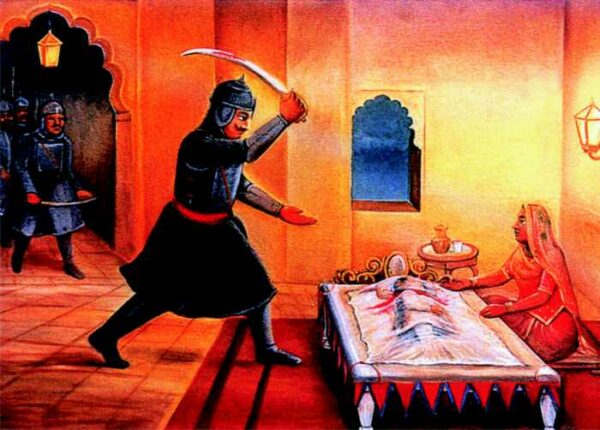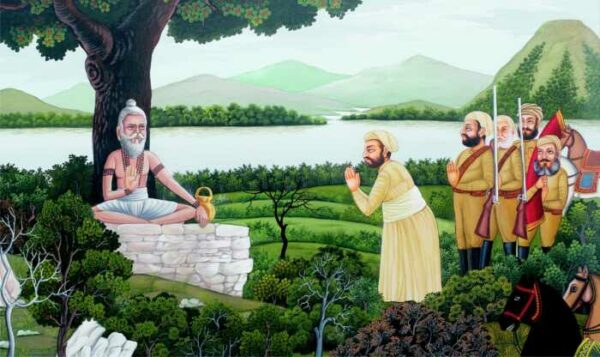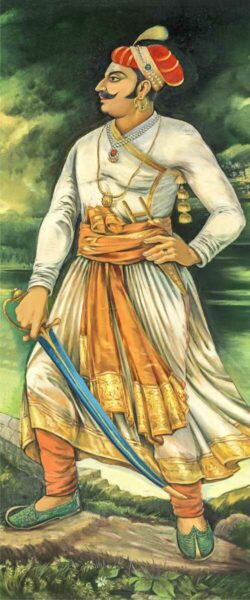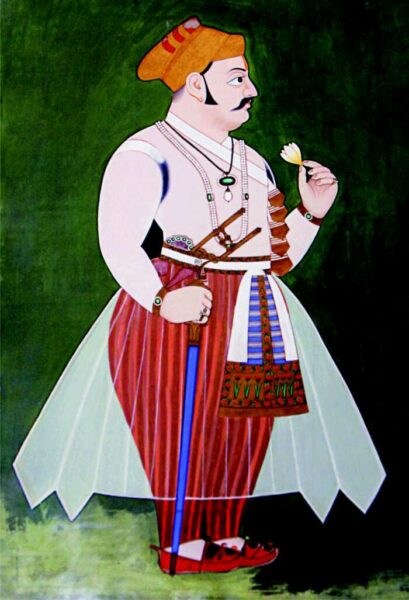
Udaipur : Maharana of Mewar Charitable Foundation, The City Palace, Udaipur is celebrating 500th Birth Anniversary of Maharana Udai Singh II (r. 1537-1572 CE), 53rd Custodian of House of Mewar, on 17th September 2021 as per Bhadrapad Shukla Ekadashi VS 2078.
Life Sketch of Maharana Udai Singh II
Maharana Udai Singh was a freedom fighter, great visionary and an able administrator however he was not duly acknowledged by scholars thus he was not recognized as a great ruler. He knew about the Jauhar of Rani Padmani in 1303 CE and of his mother Rajmata Karnavati in 1535 CE and realized that if the family stayed in Chittorgarh Fort, more stronger enemy forces would annihilate them, eventually. Hence, he thought of finding a suitable place to build his new capital. He emerged as a freedom loving and self-reliant ruler. Maharana kept the dignity of the Mewar kingdom intact even after the invasion and fall of Chittorgarh by not accepting Mughal suzerainty, which is a symbol of his courage and valor. Maharana with his vision; infused new initiative and values in his kingdom, which created faith in the kingdom itself. Through this background, Mewar emerged as a center of independence and self-respect in future under the leadership of Maharana Pratap.

Sacrifice of Pannadhai
Pannadhai, the epitome of valour and devotion, was taking care of Kanwar Udai Singh since he was staying at Ranthambore. She was a very trusted helper of Rajmata Karnavati, thus at the time of Jauhar, the responsibility of protecting Kanwar Udai Singh was also entrusted to Pannadhai. After the invasion of Bahadur Shah, the ruler of Gujarat, the Rajput army organized and re-acquired Chittorgarh and handed it over to Maharana Vikramaditya by calling him from Bundi, but there was no change in his behavior. Taking advantage of this political chaos and discontent of the chieftains, Banveer (illegitimate son of Kanwar Prithviraj, brother of Maharana Sangram Singh I) killed Maharana Vikramaditya and acquired the throne of Mewar. After the assassination of Maharana, if Banveer wanted to establish his kingdom on Mewar; he had to kill Kanwar Udai Singh too. Pannadhai was well aware of the activities and possible changes in the palace, so when Banveer came to the palace to kill Kanwar Udai Singh, Pannadhai put her sleeping son Chandan in the place of Kanwar Udai Singh. Banveer killed her son Chandan in front of Pannadhai. Pannadhai, along with her trusted companions, took Kanwar Udai Singh to a safe palace. This sacrifice of Pannadhai, to protect the descendants of Mewar kingdom became immortal in Mewar. After leaving Chittorgarh with Pannadhai, Kanwar Udai Singh, reached Kumbhalgarh via Devlia and Dungarpur. Maharana Udai Singh established contact with the chieftains of Mewar with the support of Asha Devpura, the fort in charge of Kumbhalgarh, and the chieftains dissatisfied with Banveer came to Kumbhalgarh and handed over the reins of Mewar kingdom to Maharana Udai Singh .

Early reign of Maharana Udai Singh II
With the support of the chieftains of Mewar, Maharana married Jawanta Bai, the daughter of Akhairaj Sonegara of Pali. This marriage advanced the relations of Maharana with the nobles. Along with Pali, friendly relations were also established with Maldev, the ruler of Jodhpur. Maharana strengthened his military and planned an attack on Chittorgarh. The army of Maharana and Banveer met at Mavli, in which the Maharana’s army was victorious and then reached Chittorgarh via Tana (a Thikana in Mewar). Maharana’s army attacked by entering the fort with the cooperation and diplomacy of Asha Devpura and Cheel Mehta; frightened by this unexpected attack, Banveer escaped from Lakhota gate along with his family and trusted soldiers. In 1540 CE, Maharana Udai Singh recovered Chittor. The effect of the political upheaval of North India was also visible in Rajputana. The Afghan ruler, Sher Shah captured Delhi in 1540 CE and defeated Rao Maldev, the ruler of Jodhpur in 1544 CE. At that, time the pargana of Ajmer was under the control of Jodhpur, so that too came under the authority of Sher Shah. Clouds of trouble started looming over Mewar as the next attack was probably on Chittorgarh. Chittorgarh was still facing other problems like economic losses and lack of military training, so any war was not in the interest of Mewar. Sher Shah understanding the competence of the fighters in Mewar, just wanted to establish his influence on Mewar. In these circumstances, Maharana Udai Singh in this farsightedness deftly averted the war by sending the keys of Chittorgarh fort to Shar Shah, who went away from Mewar without attacking Chittor thus Mewar was successfully saved.
Relations with neighboring kingdoms of Mewar

Maharana Udai Singh established relations with neighboring kingdoms to protect the borders of Mewar. He ensured the security of Mewar by making decisive interventions during the internal conflicts of other kingdoms. In 1554 CE, Maharana established the authority of Mewar over Bundi and then Ranthambore by sending an army under the leadership of Surjan Hada, son of his maternal uncle Arjun Hada, in the civil war against Rao Surtan, the ruler of Bundi. The friendly relations between Maharana Udai Singh and the ruler of Jodhpur, Maldev ended when Maharana agreed to marry the younger daughter of Jaitra Singh Jhala, the son of Jhala Ajja, whom Rao Maldev wanted to marry. When the Afghan, Haji Khan had lordship over Ajmer Pargana, Rao Maldev planned to attack Ajmer; with no other option, Haji Khan sought help from the Maharana. To establish friendly relations with Haji Khan, Maharana sent a combined army of Bundi, Dungarpur, Banswara and Idar to defend Ajmer. On hearing the news of Maharana’s army, Jodhpur’s army returned without fighting and Ajmer remained safe. Rao Rai Singh, the ruler of Sirohi, had cordial relations with Mewar. At the time of Rai Singh’s death, Udai Singh, the successor of the kingdom, was of a young age, so the kingdom was handed over to his brother Rao Duda. After the death of Rao Duda, Udai Singh was crowned and Duda’s son Man Singh got the Jagir of Lohiana. Angered by the behavior of Rao Udai Singh, Man Singh took refuge in Mewar. After the death of Rao Udai Singh from smallpox, the Sirohi chieftains summoned Man Singh to the throne of Sirohi, and surviving under the influence of Maharana, Man Singh accepted the authority of Mewar over Sirohi after his coronation. In this way, Maharana Udai Singh re-established the influence of Mewar in Rajputana through which he improved the military power and economic condition of Mewar.

Construction of new capital – Udaipur
The earlier tradition in Mewar and the concept of the kingdom was that; as soon as the capital collapsed, it was believed that the kingdom collapsed with it. In Mewar too, two Jauhars had already taken place to protect the capital – Chittorgarh. The security of Chittorgarh could pose a threat due to its geographical location, as it had always been the center of ambitions of political powers, being the main centre connecting North India with the western coast and Malwa. Situated on a hill, it was easy to besiege from all sides and when logistic supplies were low, opening the gates of the fort was inevitable and it was a question of Do or Die. It was difficult to defend the fort of Chittor. Apart from this, it was also not possible to form a large army due to the weak economic conditions in Mewar at that time. The war in the open plains was not a good possibility for Mewar but the survival of the ruler was necessary for the future of the kingdom. Due to these circumstances, Maharana Udai Singh propounded the idea of building a new and safer capital. For the new capital, the Maharana chose a mountainous region covered by ranges of hills in the west and south-west of Mewar, which was well protected by nature. In 1553 CE, on the day of Akshaya Tritiya, Udaipur was established in the midst of the hills of Girwa. Maharana Udai Singh tried to secure the mountainous region and encouraged the people of Mewar to settle in this area. Due to the direct contact of Mewar’s ruler, this mountainous region was developed. In 1559 CE, Maharana visited Shree Eklingnath ji Temple to commemorate the birth of his grandson, and on return went for a hunt during which the Maharana met Premgiri ji Maharaj on the banks of Pichola pond. According to the directions given by the hermit, in 1559 CE, Maharana started the construction of the palace in the capital under the direction of a Sutradhar named Raja Bhardwaj, grandson of Mandan Bhardawaj, of Kumbhalgarh fort. During the construction at Udaipur, Maharana established Gogunda, a safe place located inside the mountains, as his temporary capital. Thus, Maharana Udai Singh has the credit of establishing two capitals both Udaipur and Gogunda.

Military policy of Maharana Udai Singh II
The internal and external conflicts in the kingdom had a huge impact on the military and administrative policies of Maharana Udai Singh. Firstly, the Maharana paid attention in organizing military in Mewar and refrained from unnecessary wars and attacks. Maharana developed the hilly region by making Udaipur the center of the kingdom in order to meet the economic and military damages caused by the Saka of 1535 CE. He effectively introduced a system of defensive warfare using a limited army for self-defense. The use of heavy artillery in the mountainous region was difficult as compared to the plain areas, so the kingdom used the protection provided by nature to ensure stability. Maharana Udai Singh established cordial and marital relations with the neighboring kingdoms to secure the borders of Mewar. He provided internal security in the kingdom by cordially treating the nobility of Mewar and his influence ensured prosperity in Mewar. The neighboring kingdoms also felt safer under the leadership of Mewar. It is evident in cases of Raja of Merta, Sultan Baj Bahadur of Malwa and Raja Ramshah of Gwalior taking shelter in Mewar. To keep the subjects of the kingdom safe, they were highly encouraged to settle in the hilly areas. After establishing Udaipur, the artisans, cultivators and merchant class started settling in Udaipur after the Maharana himself. The credit for again strengthening and securing Mewar goes to the military and administrative policies propounded by Maharana Udai Singh.
Third Saka of Chittor (1568 CE)
The kingdom of the Mughal ruler Akbar was established in North India and the Rajput kingdoms were accepting the Mughal power and at that time, only Mewar was standing as an independent kingdom with its self-respecting tradition. Irrigated fertile plains and ranges always protected Mewar. The only route to connect North India with Gujarat and the southern territories passed through Mewar, so the independent kingdom of Mewar remained a major obstacle for the Mughal rule. In September 1567 CE, the Mughal ruler Akbar moved to attack Chittorgarh. Maharana had already foreseen this crisis, which is why he had already secured the establishment of Udaipur in the mountainous region and the temporary capital at Gogunda and the protection of southern along with south-west border of Mewar. Maharana’s foresight had prepared Mewar for a longer struggle. On receiving the news of the attack on Chittorgarh, Maharana started discussions with his chieftains, and the nobles advised Maharana to hand over the Chittor fort to some notable chieftains and retreat to the hills in the west along with the Mewar family and other chieftains. Everyone was aware of the loss in Mewar at the time of the Gujarat invasion, so wanted the Maharana and the successors of the kingdom to be safe; so that they could regain the lost territory in due course of time. Maharana accepted the advice of the chieftains, handed over the fort of Chittor to Jaimal and Fatta and went to the mountainous region. In October 1567 CE, the Mughal forces reached near the fort and camped. By December 1567, the Mughal army was trying to enter the fort. Due to a long struggle and end of logistics; the third Jauhar took place in Chittor with the opening of gates of the fort. The Mewar army under the leadership of Sardar Jaimal, Fatta and Kallaji sacrificed their lives by wearing saffron. In February 1568 CE, the Mughal army captured the fort.

Architecture of Maharana Udai Singh II
The architecture of Maharana Udai Singh’s reign reveals a defensive approach rather than an artistic side. The construction was done keeping the future wars in sight. The establishment and development of Udaipur city was an important initiative of Maharana. The construction also comprises of Udai Sagar, Badi Pal, Moti Magri’s palace and step wells are a strong evidence of his architectural approach. In the palace of Udaipur, Navchoki, Panera, Rai Angan, Nika ki Chaupad, Pandeyji ki Ori, Sej ki Ori, Zenana Rawala (currently Kothar) and Darikhana Ki Pol were built by Maharana Udai Singh. Apart from this, the construction of Udai Shyam temple on the bank of Udaisagar also took place during the reign of the Maharana. A palace was also built by Maharana in Gogunda, the temporary capital of Mewar. Apart from Maharana, his family was also involved in the development of this area. In 1554 CE, Maharani Sonagari built Badla Wali Sarai and Panghat Baori. Maharani Sahajkunwar Solanki got the Sarai, the step well and the Shiva temple built. Maharani Dheer Kunwar built a step well, a temple and an inn outside the village of Debari. The efficient planning and vision of Maharana populated the Girwa region.
Maharana Udai Singh II religious benovelance
Maharana Udai Singh was religiously inspired by Bhaktimati Meera Bai in his childhood, from which he got the knowledge and respect for religion. The inspiration for the construction of the Udaiashyam temple on the bank of Udaisagar is the result of this association. According to Shreenathji’s Prakya Varta, when Goswami Vitthalnathji reached Mewar during his yatra to Dwarka, he graciously predicted that, after a few years Shreenathji Prabhu would arrive in Mewar, and a temple will be established. Maharana Udai Singh went with the royal family for the darshan of Goswami ji and he presented village Sinhad (present Nathdwara) and gold Mohar. He received gracious blessings from Goswami ji, that the fame of Maharana’s lineage will always be maintained. In Vikram Samvat 1602 (1545 CE), Maharana had consecrated the Shikhar Kalash of Shree Parameshwaraji Maharaj Shree Eklingnathji Temple.
Demise
Maharana spent his maximum time in Kumbhalgarh after leaving Chittorgarh. Maharana went to Gogunda on the occasion of Vijayadashami in Vikram Samvat 1628, and he left the world on Falgun Shukla Poornima because of ill health. The capital Udaipur was not fully developed yet and Gogunda was the temporary capital of Mewar, so he was cremated in Gogunda. A chhatri was constructed at the cremation site.

